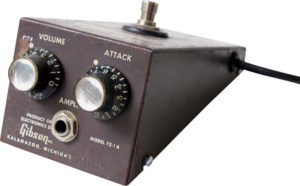- in Gear , Guitar , Hardware , MI/Audio Business by Bobby Owsinski
How The Fuzz Tone Was Born
 If you’re a guitar player, chances are you’re in love with the distorted sound that’s so easy to create these days, thanks to a variety of amps, pedals and plugins. In fact, it’s hard to imagine a time when guitar distortion didn’t exist, but believe it, there was a time when there was no such thing. In fact, the story about how the original “fuzz tone” was born takes a number of unusual twists that are pretty amazing for such a ubiquitous sound.
If you’re a guitar player, chances are you’re in love with the distorted sound that’s so easy to create these days, thanks to a variety of amps, pedals and plugins. In fact, it’s hard to imagine a time when guitar distortion didn’t exist, but believe it, there was a time when there was no such thing. In fact, the story about how the original “fuzz tone” was born takes a number of unusual twists that are pretty amazing for such a ubiquitous sound.
While the music world freely accepts that the first distorted guitar on record was the 1951 Jackie Brenston/Ike Turner hit “Rocket 88” where guitarist Willie Kizart reportedly poked a hole in his amp’s speaker to make it fuzz out, (later emulated by Link Wray on “Rumble” and Dave Davies of The Kinks on “You Really Got Me”), making that sound reliably repeatable came about as an accident in the summer of 1960 in Nashville.
Country star Marty Robbins was in Bradley Film & Recording Studios, in Nashville (the famous Quonset Hut) recording a ballad for Decca called “Don’t Worry.” Backing him was the A-Team, Nashville’s best session players, which included guitar player Grady Martin.
The Quonset Hut had just received a new custom-built console with Langevin 116 tube amplifiers, but unbeknownst to everyone involved, it contained 35 output transformers wound by another manufacturer while Langevin moved to the West Coast. The problem was that these transformers weren’t up to spec, and during the session one of them failed on Grady Martin’s six string bass channel, causing it to distort, but in a musical way that everyone on the session loved.
Word spread around Nashville about this interesting new sound, and people began to specifically ask for it, so Glenn Snoddy, the engineer on the session, built a box that emulated the sound of the console distortion – the first stompbox!
The big difference was that the Langevin module was tube-based, while Snoddy’s box was all transistor. It didn’t matter though, because studio guitarists loved it.
In 1962 Snoddy sold the manufacturing rights to Gibson, who then released the “Fuzz Tone” under its Maestro label. Dealers snapped up all 5,000 units produced in 1962, which was great for the company. The only problem was that guitar players refused to buy them. Reportedly, Gibson shipped only three Fuzz-Tones in ’63 and none in ’64.
So what changed their minds? In 1965 Rolling Stone Keith Richards used a Fuzz Tone (the model FZ-1) on “(I Can’t Get No) Satisfaction” and the rest is history. From that point on, guitarists couldn’t get enough of the sound, which has evolved over time. While we each have our idea of a good and bad distortion, if you life is connected to the guitar, you can’t live without it.
Get the story directly from Glenn Snoddy on this video.
